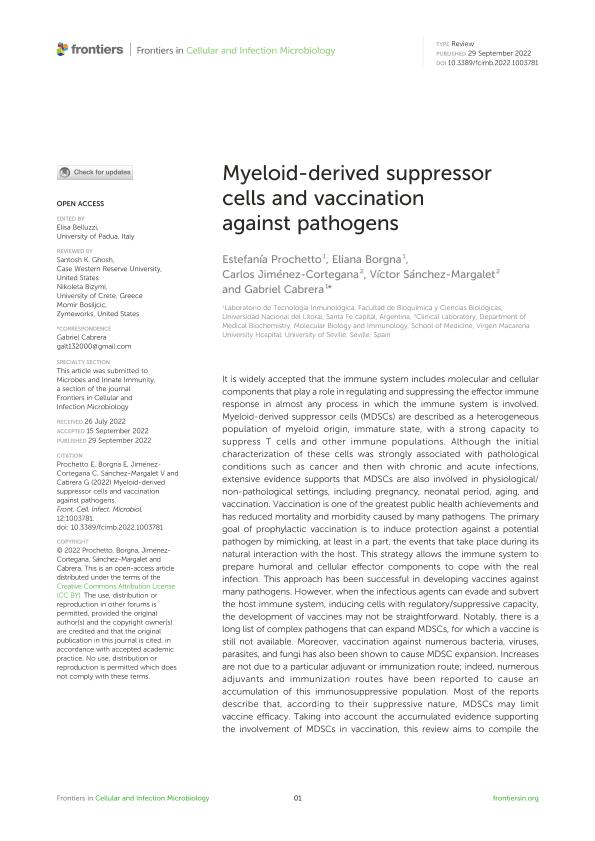Mostrar el registro sencillo del ítem
dc.contributor.author
Prochetto, Estefanía Soledad

dc.contributor.author
Borgna, Eliana Vanesa

dc.contributor.author
Jiménez Cortegana, Carlos
dc.contributor.author
Sánchez Margalet, Víctor
dc.contributor.author
Cabrera, Gabriel Gustavo

dc.date.available
2024-01-16T12:49:49Z
dc.date.issued
2022-09
dc.identifier.citation
Prochetto, Estefanía Soledad; Borgna, Eliana Vanesa; Jiménez Cortegana, Carlos; Sánchez Margalet, Víctor; Cabrera, Gabriel Gustavo; Myeloid-derived suppressor cells and vaccination against pathogens; Frontiers Media; Frontiers in Cellular and Infection Microbiology; 12; 9-2022; 1-14
dc.identifier.issn
2235-2988
dc.identifier.uri
http://hdl.handle.net/11336/223718
dc.description.abstract
It is widely accepted that the immune system includes molecular and cellular components that play a role in regulating and suppressing the effector immune response in almost any process in which the immune system is involved. Myeloid-derived suppressor cells (MDSCs) are described as a heterogeneous population of myeloid origin, immature state, with a strong capacity to suppress T cells and other immune populations. Although the initial characterization of these cells was strongly associated with pathological conditions such as cancer and then with chronic and acute infections, extensive evidence supports that MDSCs are also involved in physiological/non-pathological settings, including pregnancy, neonatal period, aging, and vaccination. Vaccination is one of the greatest public health achievements and has reduced mortality and morbidity caused by many pathogens. The primary goal of prophylactic vaccination is to induce protection against a potential pathogen by mimicking, at least in a part, the events that take place during its natural interaction with the host. This strategy allows the immune system to prepare humoral and cellular effector components to cope with the real infection. This approach has been successful in developing vaccines against many pathogens. However, when the infectious agents can evade and subvert the host immune system, inducing cells with regulatory/suppressive capacity, the development of vaccines may not be straightforward. Notably, there is a long list of complex pathogens that can expand MDSCs, for which a vaccine is still not available. Moreover, vaccination against numerous bacteria, viruses, parasites, and fungi has also been shown to cause MDSC expansion. Increases are not due to a particular adjuvant or immunization route; indeed, numerous adjuvants and immunization routes have been reported to cause an accumulation of this immunosuppressive population. Most of the reports describe that, according to their suppressive nature, MDSCs may limit vaccine efficacy. Taking into account the accumulated evidence supporting the involvement of MDSCs in vaccination, this review aims to compile the studies that highlight the role of MDSCs during the assessment of vaccines against pathogens.
dc.format
application/pdf
dc.language.iso
eng
dc.publisher
Frontiers Media

dc.rights
info:eu-repo/semantics/openAccess
dc.rights.uri
https://creativecommons.org/licenses/by-nc-sa/2.5/ar/
dc.subject
BACTERIA
dc.subject
IMMUNIZATION
dc.subject
MDSCS
dc.subject
MYELOID-DERIVED SUPPRESSOR CELLS
dc.subject
PARASITES
dc.subject
PATHOGENS
dc.subject
VACCINE
dc.subject
VIRUSES
dc.subject.classification
Inmunología

dc.subject.classification
Medicina Básica

dc.subject.classification
CIENCIAS MÉDICAS Y DE LA SALUD

dc.title
Myeloid-derived suppressor cells and vaccination against pathogens
dc.type
info:eu-repo/semantics/article
dc.type
info:ar-repo/semantics/artículo
dc.type
info:eu-repo/semantics/publishedVersion
dc.date.updated
2024-01-16T10:55:19Z
dc.journal.volume
12
dc.journal.pagination
1-14
dc.journal.pais
Suiza

dc.journal.ciudad
Lausana
dc.description.fil
Fil: Prochetto, Estefanía Soledad. Universidad Nacional del Litoral. Facultad de Bioquímica y Ciencias Biológicas. Laboratorio de Tecnología Inmunológica; Argentina. Consejo Nacional de Investigaciones Científicas y Técnicas. Centro Científico Tecnológico Conicet - Santa Fe; Argentina
dc.description.fil
Fil: Borgna, Eliana Vanesa. Universidad Nacional del Litoral. Facultad de Bioquímica y Ciencias Biológicas. Laboratorio de Tecnología Inmunológica; Argentina
dc.description.fil
Fil: Jiménez Cortegana, Carlos. Universidad de Sevilla; España
dc.description.fil
Fil: Sánchez Margalet, Víctor. Universidad de Sevilla; España
dc.description.fil
Fil: Cabrera, Gabriel Gustavo. Universidad Nacional del Litoral. Facultad de Bioquímica y Ciencias Biológicas. Laboratorio de Tecnología Inmunológica; Argentina. Consejo Nacional de Investigaciones Científicas y Técnicas. Centro Científico Tecnológico Conicet - Santa Fe; Argentina
dc.journal.title
Frontiers in Cellular and Infection Microbiology
dc.relation.alternativeid
info:eu-repo/semantics/altIdentifier/url/https://www.frontiersin.org/articles/10.3389/fcimb.2022.1003781/full
dc.relation.alternativeid
info:eu-repo/semantics/altIdentifier/doi/http://dx.doi.org/10.3389/fcimb.2022.1003781
Archivos asociados
